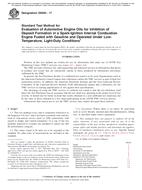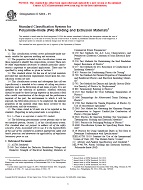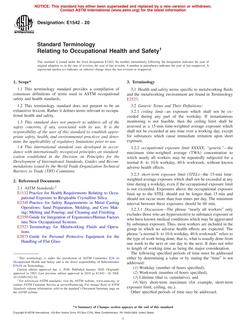1.1 These laboratory test methods cover the frost heave and thaw weakening susceptibilities of soil that is tested in the laboratory by comparing the heave rate and thawed bearing ratio with values in an established classification system. This test was developed to classify the frost susceptibility of soils used in pavements. It should be used for soils where frost-susceptibility considerations, based on particle size such as the limit of 3 % finer than 20 mm in Specification D 2940, are uncertain. This is most important for frost-susceptibility criteria such as those used by the Corps of Engineers, that require a freezing test for aggregates of inconclusive frost classification. The frost heave susceptibility is determined from the heave rate during freezing. The thaw weakening susceptibility is determined with the bearing ratio test (see Test Method D 1883).
1.2 This is an index test for estimating the relative degree of frost-susceptibility of soils used in pavement systems. It cannot be used to predict the amount of frost heave nor the strength after thawing, nor can it be used for applications involving long-term freezing of permafrost or for foundations of refrigerated structures.
1.3 The test methods described are for one specimen and uses manual temperature control. It is suggested that four specimens be tested simultaneously and that the temperature control and data taking be automated using a computer.
1.4 All recorded and calculated values shall conform to the guide for significant digits and rounding established in Practice D 6026.
1.4.1 The procedures used to specify how data are collected/recorded and calculated in this standard are regarded as the industry standard. In addition, they are representative of the significant digits that should generally be retained. The procedures used do not consider material variation, purpose for obtaining the data, special purpose studies, or any considerations for the users objectives; and it is common practice to increase or reduce significant digits of reported data to be commensurate with these considerations. It is beyond the scope of this standard to consider significant digits used in analysis methods for engineering design.
1.4.2 Measurements made to more significant digits or better sensitivity than specified in this standard shall not be regarded a nonconformance with this standard.
1.5 This Standard is written using SI units. Inch-pound units are provided for convenience. The values stated in inch pound units may not be exact equivalents; therefore, they shall be used independently of the SI system. Combining values from the two systems may result in nonconformance with this standard.
1.5.1 The gravitational system of inch-pound units is used when dealing with inch-pound units. In this system, the pound (lbf) represents a unit of force (weight), while the unit for mass is slugs. The rationalized slug unit is not given, unless dynamic (F=ma) calculations are involved.
1.5.2 It is common practice in the engineering/construction profession to concurrently use pounds to represent both a unit of mass (lbm) and of force (lbf). This implicitly combines two separate systems of units; that is, the absolute system and the gravitational system. It is scientifically undesirable to combine the use of two separate sets of inch-pound units within a single standard. As stated, this standard includes the gravitational system of inch-pound units and does not use/present the slug unit for mass. However, the use of balances or scales recording pounds of mass (lbm) or recording density in lbm/ft3 shall not be regarded as nonconformance with this standard.
This standard does not purport to address all of the safety concerns, if any, associated with its use. It is the responsibility of the user of this standard to establish appropriate safety and health practices and determine the applicability of regulatory limitations prior to use.
Product Details
- Published:
- 11/01/2006
- Number of Pages:
- 12
- File Size:
- 1 file , 290 KB
- Redline File Size:
- 2 files , 560 KB


